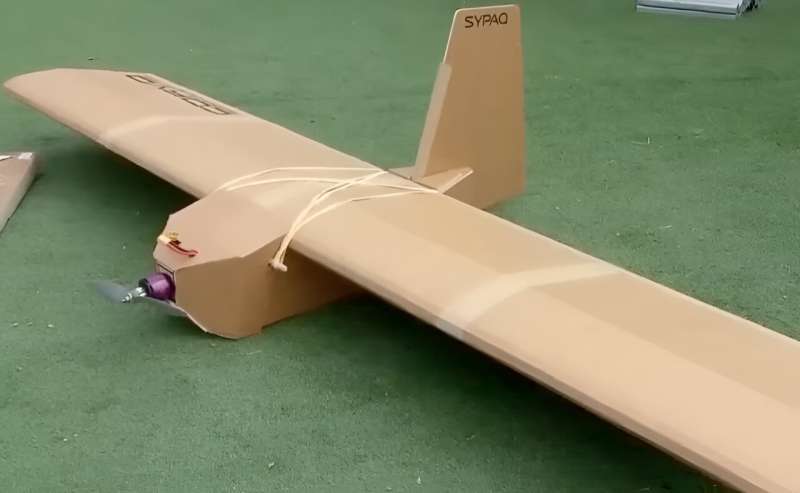This article has been reviewed according to Science X's editorial process and policies. Editors have highlighted the following attributes while ensuring the content's credibility:
fact-checked
trusted source
written by researcher(s)
proofread
Ukraine war: Australian cardboard drones used to attack Russian airfield show how innovation is key to modern warfare

Innovative design choices can have a massive impact in the theater of war, so it is important to understand the principles behind their development. Recent use of low-cost cardboard drones by Ukraine, supplied by Australia, to attack targets in Russia is a good example of how this can work.
Australia has been supplying Ukraine with 100 of the drones per month from March this year as part of an aid package deal worth an estimated £15.7 million, following an agreement struck in July 2021, according to the Australian Army Defense Innovation Hub.
Emerging technologies tend to override current technologies, and in turn, this generates competitive counter-technologies. This circular relationship driven by innovation is often critical in warfare as it can provide key technological advances.
Drone technology was originally developed for military use. It was then seen to offer opportunities in the civilian sphere for logistics, delivery and disaster relief. This then in turn has offered new innovations that can translate to military applications.
Conflicts in the future will be particularly shaped by drones, which will have implications for international relations, security and defense.
The Australian firm Sypaq, an engineering and solutions company founded in 1992, created the Corvo Precision Payload Delivery System (PPDS) for use in military, law enforcement, border security and emergency services, as well as food security, asset inspection and search and rescue.
Ukrainian forces reportedly used the PDDS cardboard drones in an attack on an airfield in Kursk Oblast in western Russia on August 27. The attack damaged a Mig-29 and four Su-30 fighter jets, two Pantsir anti-aircraft missile launchers, gun systems, and an S-300 air surface-to-air missile defense system.
Design principles
The design principles behind the success of the drones revolve around several factors including the production cost, airframe material, weight, payload, range, deployment and ease of use. Other considerations include the reliability of the operating software and the ability to fly the drone in various weather conditions.
Generally, small drones offer high-resolution imagery for reconnaissance in a rapidly changing theater of war. The Corvo drone has a high-resolution camera that provides images covering a large area, transmitting footage back to its user in real time.
The importance of real-time mapping is critical in modern agile armed forces' command and control as this can direct ground forces, heavy weapons and artillery.
In some cases, the design of small drones is concentrated on adapting the payloads to carry different types of munitions, as seen in the attack in Kursk.
The cardboard drones can carry 5kg of weight, have a wingspan of two meters and a range of 120km at a reported cost of US$3,500 (£2,750). Waxed cardboard is an ideal material as it offers weather resistance, flat-pack transportation (measuring 510mm by 760mm) and, importantly, a lightweight airframe, which enables a longer flight range and a high cruise speed of 60km/h.
Fixed-wing drones also offer longer ranges than rotor-based drones as the wings generate the lift and the airframe has less drag, so they are more energy efficient. They can also fly at higher altitudes. The drones can be launched from a simple catapult or by hand and so can be rapidly deployed.
Low-tech material, hi-tech thinking
Radar involves the transmission of electromagnetic waves, and these are reflected off any object back to a receiving antenna. Cardboard is generally harder to detect by radar—but its components, such as the battery, can be detected.
But the Corvo drone is likely to have a small signature. Radar-absorbing materials are needed to have full stealth properties. These polymers have various absorbing qualities to avoid radar detection.
Another design principle is the swarming capability of the drone. Swarms of drones can overpower air defense systems through sheer volume and or can be used as decoys in counterintelligence operations.
Swarms are highly reliant on the development of artificial intelligence, which is still an embryonic research area. But a recent drone race at ETH University in Zurich, in which AI-piloted drone beat drones controlled by world-champion drone racers, highlighted this potential.
All of these design principles and innovations have and are continuing to transform warfare and theater operations. It is likely that small drones at low cost are likely to have further mission success in the future.
This article is republished from The Conversation under a Creative Commons license. Read the original article.![]()


















